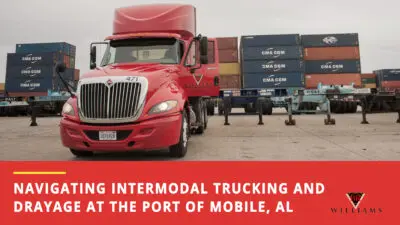
All logistic professionals are focused on optimizing the supply chain and enhancing its efficiency. Improving efficiency can mean getting products into the hands of consumers faster, cutting shipping costs, and reducing labor costs – or a combination of all three.
If you are looking to improve the efficiency of your company’s logistics, a cross-docking (aka. Transloading) strategy from a cross docking service may be the perfect solution for your needs.
What Is Cross-Docking?
Cross-docking is a lean supply chain model that involves the immediate or faster transfer of finished goods directly from suppliers or manufacturers to customers or retailers with little to no handling or storage.
This might mean stopping a truck at a distribution center’s inbound dock to move goods from it directly to an outbound truck in an outbound dock without storing the inventory inside the cross-docking warehouse.
Cross-docking enables businesses to accelerate the fulfillment process and creates faster replenishment, reduces middle- and last-mile shipping costs by positioning inventory closer to the end customer, and allows companies to service their end customers better. Wins all around!
How does Cross-Docking work?
Cross-docking isn’t a complicated process, but it does require some expertise and planning to execute efficiently.
Simply put, cross-docking includes:
- Truckloads arrive at the entrance of a warehouse’s loading docks
- The goods get unloaded and sorted from the first truck and loaded into other trucks waiting on-site in the outbound transportation dock, ready to take off
- The newly loaded trucks deliver the goods to the customers and eliminate the need for products to sit in storage
While it’s a relatively simple model, it requires exact precision and perfect planning to keep things organized and on track. So it’s no surprise that the process was first created for military shipments in the 1950s.
Making it work for you
The great thing about cross-docking is that you can pick and choose what products you want to cross-dock and what products you want to handle traditionally. And if you own your warehouse, you’re in complete control of it all which allows for opportunistic cross-docking. On the other hand, if you outsource your warehouse and shipping, you can talk to 3PL providers like BR Williams about implementing cross-docking for your products.
Benefits of Cross-Docking
Cross-docking enables a leaner supply chain and is perfect for businesses wanting to accelerate their order fulfillment process, reduce overall costs, and speed up the time it takes for products to reach their final destinations.
Reduced costs and time savings
A huge benefit, cross-docking can reduce costs and save time. Since items don’t need to be picked and stored in a warehouse, there is a reduction in labor and warehouse storage costs.
Cost of goods sold (COGS) accounts for a significant portion of inventory expenses. A business has to purchase a product, and they are also required to pay for first-mile and last-mile shipping and carrying costs.
Additionally, containers can be unloaded and returned to the port, saving time on drayage and chassis fees and reducing detention charges for shipments further away from the dock.
Overweight containers can also be unloaded close to the port and shipped to their final destinations in dry vans of legal weight.
Faster shipping & receiving times
Cross-docking also benefits the consumer by reducing shipping times and, in turn, increasing consumer satisfaction rates. This reflects well upon the business and keeps customers coming back for more.
Since storing products requires labor that can be reduced or eliminated, goods reach the final destination much sooner. In addition, shipping efficiency increases because bigger batches get broken down into smaller shipments and loaded onto freights going in the same direction. This also allows all divisions – trucking, warehouse, and logistics – to participate in the process.
Receiving inventory is also less complex since receiving only requires accounting for inventory being received and then shipped, rather than scanning inventory into a WMS and optimizing the movement of goods.
Enhance product quality
Third, cross-docking can enhance product quality. Since cross-docking reduces the time between production and end delivery, it helps preserve the quality of perishable items. It can help ensure package handoff isn’t causing damage to the goods.
Give flexibility to your carriers and drivers
While your bottom line may be a primary focus, your people should also be considered. For example, cross-docking allows drivers to get home without waiting hours or days for a missed appointment.
This also provides carriers and drivers an option to secure loads before reaching their final destination without the risk of the customer refusing the load because of load shift, damage, etc.
Cross-docking also provides carriers that need to get drivers elsewhere with an option to empty a trailer and move a driver without having to lose money sitting waiting for an appointment.
Who can Benefit From Cross-Docking
Cross-docking is the term that importers and exporters commonly use when they experience stable, consistent demand and high inventory turnover. While that is often the case, almost any business can utilize this process if it fits within their supply chain strategy and infrastructure. This is a very effective strategy for those wanting to accelerate their order fulfillment, reduce costs, and speed up their processes.
How is a Cross-Docking Strategy Set Up?
A cross-docking strategy minimizes warehousing activities and labor by immediately transferring freight from one mode of transportation to another at the docking facility. This type of method helps deliver cost savings and ensures faster fulfillment time. A trusted cross-docking service partner like your friends at BR Williams can handle the logistics for you and ensure your strategy is working for your products.
READ: Cross-docking, or Intermodal Draying, and when to use one or the other
READ: The Benefits of Cross-Docking, and the Port of Mobile, AL
Use the Power of Cross-Docking for Supply Chain Optimization Today!
BR Williams is the leading provider of cross-docking in the Southeast USA and helps businesses like yours harness the power of cross-docking through the Port of Mobile and efficiently execute these strategies. If you’re ready to take your business to the next level, contact us today to learn more.
About BR Williams Trucking & Logistics
BR Williams, a family-owned Trucking, Warehousing, Fulfillment & Logistics Company has been serving customers since 1958. We specialize in removing the supply chain frustrations our customers have by developing custom-made solutions. We offer nationwide transportation services through our fleet and logistics division. Our multiple fulfillment and distribution warehouses in Alabama span over 1.7 million square feet. Our core values are HONESTY, INTEGRITY, SERVICE. We still serve our first customer that was established in 1958.
To discuss your supply chain needs, please contact us online or call (800) 523-7963



